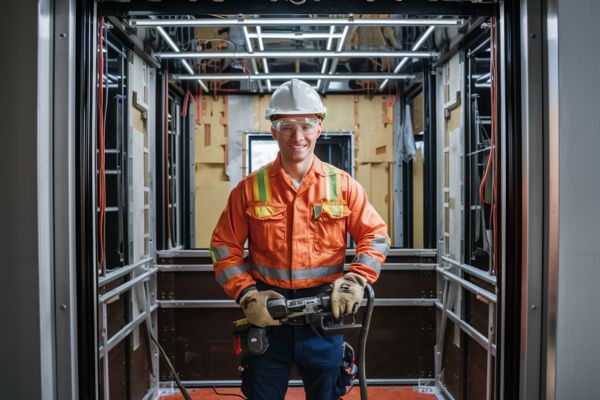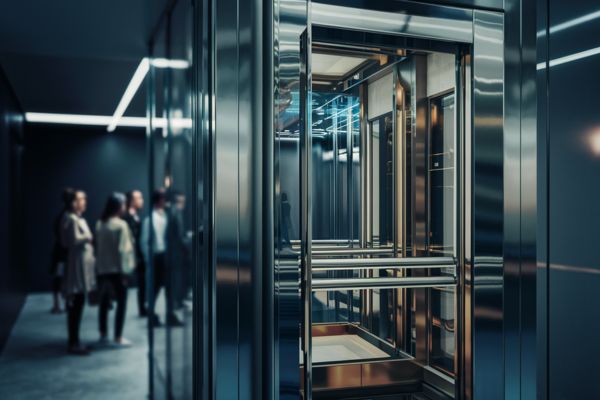In today’s changing market, supply change, and labor changes, understanding the intricate process of installing an elevator requires expertise and knowledge of the elevator industry for a precise implementation within budget and time frame.
These tips illuminate the intricacies of elevator installation, the steps involved, the associated costs, and the essential factors to guarantee a successful project. The overall installation of an elevator should be mindful of whether it is a new installation, a modernization, or an upgrade.
Understanding the elevator installation process
Installing an elevator begins with a detailed understanding of the elevator installation process. From commercial buildings seeking to enhance performance to residential properties aiming for increased uptime and user experience, the procedure encompasses several stages:

Planning and Design
This initial phase involves selecting the correct type of elevator based on building requirements, purpose, and user traffic. The design process considers the elevator’s capacity, speed, and energy efficiency, tailoring it to the building’s needs, including tenants and moving goods if necessary.
The chosen elevator contractor must follow a detailed scope of work for the entire elevator system. This scope of work should include terms that protect the building during and after installation.
Permit and Approval
Securing necessary permits and approvals from local authorities ensures the installation complies with building codes and safety standards. The selected contractor usually obtains these permits for the commercial elevator installation. The authority having jurisdiction will issue the licenses and release them once the installation is completed.
Site Preparation
Preparing the site for installation involves creating the elevator shaft, machine room, if required, and pit for new installation. For elevator modernization, the old equipment is removed, the areas are prepped, and the latest equipment is installed with all the latest code requirements. This groundwork with appropriate scope of work lays the foundation for a smooth elevator installation process.
Related article: Elevator Modernization: A Comprehensive Guide
Installation
Professional elevator installation companies undertake the task of assembling and installing the elevator system. This includes following the requirements of the scope of work and following it as described, including all components mentioned. The submittals should be on hand for guidance on what was approved and ordered.
Need Help with Elevator New Construction & Installation?
Testing and Commissioning
Before the elevator is ready for use, it undergoes rigorous testing to confirm its operational efficiency, safety, and compliance with regulations. The authority having jurisdiction will complete their inspection before releasing the permit. The elevator contractor will also run several tests and train key personnel.
Related article: Navigating the Compliance Maze: How The Elevator Consultants Streamline Elevator Inspection Management
Elevator installation cost: A key consideration
The cost of elevator installation varies significantly based on the elevator type, the installation’s complexity, and the building’s requirements. While commercial elevator installations generally involve higher expenditures due to their sophisticated features and higher capacity.
Seeking quotes from reputable elevator installation companies based on the detailed scope of work can provide a clearer picture of the investment required.
Choosing the right installation partner
Selecting a proficient elevator contractor for the installation is paramount to the success of your project. Look for providers with a track record of reliable installations, adherence to safety standards, and comprehensive after-installation support. An elevator consultant can help you through the process.
Other considerations in elevator installation
While the basics of elevator installation cover the process, costs, and the choice of a reliable installation partner, nuanced considerations can significantly influence your elevator system’s success and functionality.

Energy Efficiency and Sustainability of the Elevator
Integrating energy-efficient features into your elevator system is beneficial for the environment and can lead to cost savings over time. Consider options such as regenerative drives and LED lighting in the elevator cabin. Evaluating long-term energy consumption and exploring sustainable materials and technologies is also worth considering.
Elevator Customization for User Experience
Beyond functionality, the user experience is paramount. Many customization options include cabin interiors crafted from luxurious materials and advanced control systems that reduce wait times. Incorporating features such as touchless controls, voice-activated commands, and interactive displays can significantly enhance user satisfaction.
Future-Proofing the Elevator
Technology evolves rapidly, and the elevator industry is no exception. Opting for an elevator system that allows for easy updates and adaptations to new technologies is vital. This might include software updates for elevator controls or modular components that can be upgraded as better versions become available. Future-proofing your installation ensures longevity and adaptability, keeping your system modern and efficient for years.
Elevator installation is a complex process for both new installations and modernizations. By understanding the essentials—from the scope of work, installation procedure, and costs to selecting the right elevator contractor—you ensure that your building’s vertical transportation system is not just a mode of transit but a testament to safety, efficiency, and innovation. The elevator users will ride with ease and confidence.
Have a Question About Elevators?
Talk to a Professional Elevator Consultant
FAQs: Elevator Installation Uncovered
How does an elevator get installed?
Installation involves a detailed scope of work, site preparation, equipment installation, testing, inspections, training, and warranty, which are all part of the installation process. The time of installation is based on what is being installed and the height of the building, ranging from 8 weeks to 16 weeks.
Where is the best place to put an elevator?
This is for new installation, and a design firm will assist in the optimal location depending on the building’s design and usage patterns, typically where it can serve the users efficiently.
Which is cheaper, an escalator or an elevator?
This question is answered based on usage, traffic flow, and space, among other requirements. Hiring an elevator consultant can assist with these decisions.
What materials are needed for an elevator?
Several materials are needed for an elevator. On a high level, these include steel for the shaft, cables, and frame, along with electrical components for operation and safety systems.
How many floors before an elevator is required?
Regulations vary, but generally, buildings over two to three stories high have an elevator.
How much space do you need to install an elevator?
The space requirement depends on the elevator type and capacity. Elevator sizes can be “off the shelf” or customized.
What is the most important part of the elevator?
The elevator is an elevator system, and all components are critical to an elevator.
How do you protect an elevator during construction?
It depends on the type of construction; however, employing protective barriers and covers, along with strict operational protocols, safeguards the elevator during construction.

